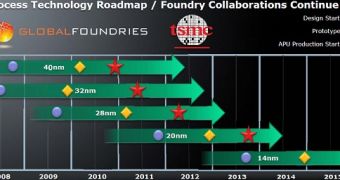AMD recently held a conference where it disclosed some more details on its upcoming line of Fusion accelerated processing units (APUs), and it seems that it plans to use a special architectural feature when making low-power chips.
As end-users well know by now, Advanced Micro Devices will finally bring out its Fusion processors next year.
The technology has been in development for years and implies the merger of a CPU and a DirectX 11 GPU on a single die.
There have been several updates on AMD's plans in relation to desktop, laptop and server processors already.
Now, X-bit Labs reports that the company also had come concrete things to say about the low-power APUs.
Apparently, Advanced Micro Devices will employ what it called half-node process technologies.
AMD also stated that most of its APUs would be manufactured by Globalfoundries and, while it did not say anything specific, it also said that the Krishna and Wichita APUs would use “gate-first” technology.
Since Globalfoundries is among the few companies currently developing a 28nm HKMG gate-first fabrication process, it can be assumed that it will make those chips as well.
It should be noted, however, that Chekib Akrout, senior vice president of technology group at AMD, did not answer the question on whether it would be TSMC or Globalfoundries that will provide the 28nm process.
Currently, however, TSMC has only the HKMG gate-last approach to the 28nm node.
"We are going to move to half-node cadence, which means 28nm, 20nm and 14nm. That allows us to be more industry-standard and support all our APU products,” Mr. Akrout said.
“The move to 28nm will allow us to [release new APUs every year]," he added.
Recently, the Sunnyvale, California-based outfit also offered updates on the Ontario and Zacate APUs, which are already shipping, as well as on 20-core Bulldozer server chips.

 14 DAY TRIAL //
14 DAY TRIAL //